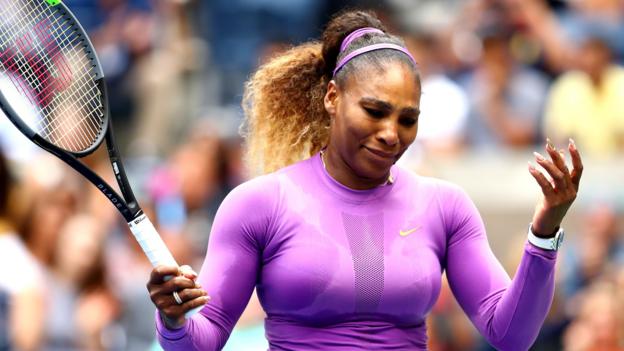
"The bigger the occasion, the bigger she hits," Bianca Andreescu's coach said before the Canadian's US Open final victory.
Sylvain Bruneau was talking about the 19-year-old, but it could have equally applied to Serena Williams, her opponent, at pretty much any point over the past 20 years.
But something has changed in Grand Slam finals of late.
For Williams to reach the 2018 Wimbledon final, just 10 months after her traumatic experience in labour, was nothing short of miraculous. And for the American to do the same at last year's US Open, with very few matches in between, was another phenomenal feat.
Angelique Kerber and Naomi Osaka played extremely well to win those finals, Simona Halep was exceptional in this year's Wimbledon final, and the poise, belief and skill of Andreescu at Flushing Meadows on Saturday was quite something to watch.
A growing group of players now believe they have what it takes to beat the 23-time Grand Slam champion - who is one short of Australian Margaret Court's all-time record - when a trophy is on the line.
Williams, 37, may think she has the beating of them, but it does not appear that way, and she did not play nearly as well in the final as she had done in earlier rounds.
Her movement, so impressive in the semi-finals against Elina Svitolina, was much more laboured. And her serve was much diminished.
Williams was broken three times in six matches before the final. On Saturday, she was broken six times in two sets.
She made just 44% of first serves. She won only 30% of her second-serve points. And she sent down eight double faults.
Her serve recovered, briefly, as she won four games in a row to level the second set to thunderous encouragement from the Arthur Ashe Stadium crowd.
Andreescu put her fingers in her ears to block out the noise but then, at 5-5 and with the Canadian only too aware a championship point had come and gone, the confident and clinical Williams disappeared.
Her serve and her groundstrokes became edgy and tentative, as Andreescu regained the composure which would earn her a richly deserved first Grand Slam title.
"Serena...," Williams said, addressing herself in a post match news conference. "You didn't miss a serve, you lost serve maybe twice in the whole tournament, and you didn't hit a first serve in today.
"That was obviously on my mind. How do I play at a level like this in a final?"
The 2013 Wimbledon champion Marion Bartoli, a close friend of Williams, thinks the American puts extra pressure on herself, and cannot rid that from her mind when she steps on to court.
"She just feels she has to win this one, and it has to be that one that she's going to get to 24, and then to 25 [Grand Slam titles]," Bartoli told BBC Radio 5 Live last week.
Williams' next opportunity to draw level with Court's record will come at the Australian Open in Melbourne in January.
Winning a final on the WTA Tour between now and then might do Williams a power of good, but will she want to compete in Asia in the final stretch of the year?
She has not played any tournaments after the US Open for five years. In 2014, when she last played and won the WTA Finals, she went on to win the Australian Open, the French Open and Wimbledon the following year.
After 22 years on tour - and with a two-year-old child to consider - another spell away from home may not remotely appeal. But surely a few more tournaments, and the chance to play at least three matches against top-eight opponents at the WTA Finals in Shenzhen, would be an excellent springboard into 2020?
Williams, of course, has absolutely nothing to prove. To most, she is already considered the greatest of all time - in the women's game at the very least. She has been in Grand Slam finals 20 years apart, and has won all of her major titles in the Open era.
But she so desperately wants to equal, and then surpass, Court's tally.
Further opportunities may well arise, but it is now entirely reasonable to ask if, rather than when, she will do it.















 Phone: (800) 737. 6040
Phone: (800) 737. 6040 Fax: (800) 825 5558
Fax: (800) 825 5558 Website:
Website:  Email:
Email: 






